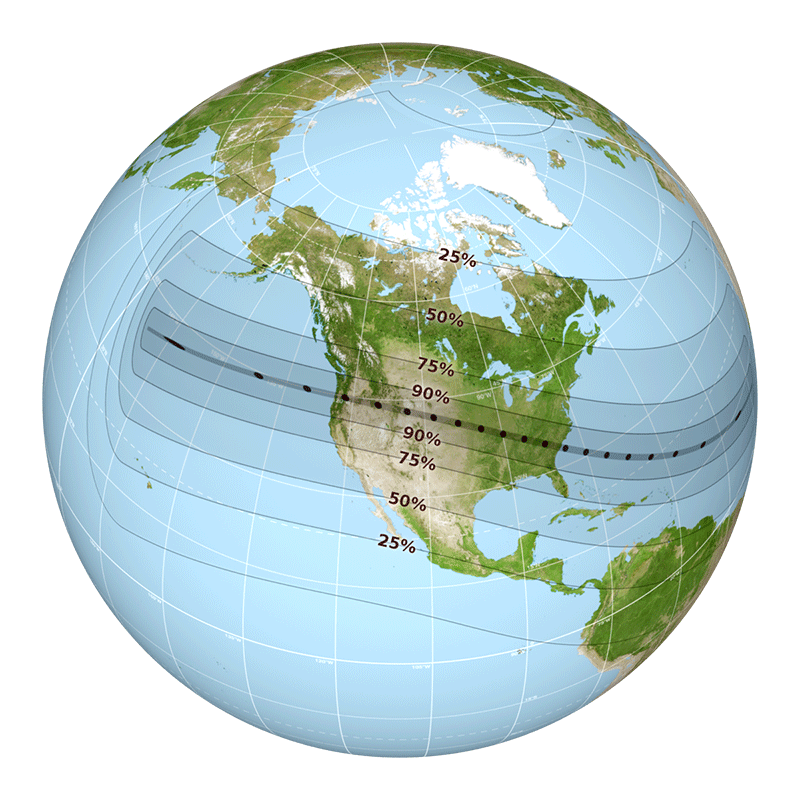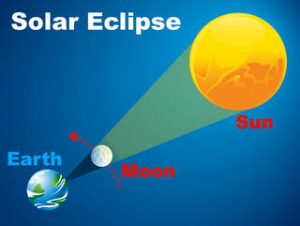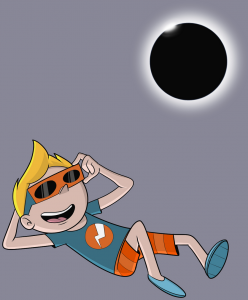
The continental United States will be treated to a rear opportunity on Monday, August 21, 2017: a total solar eclipse. A solar eclipse occurs when the moon, while orbiting the Earth, blocks the light of the sun from reaching the Earth. Rather than the sun light being able to reach the earth, the moon casts a shadow on the Earth. There are three types of solar eclipses: total, partial, and annular. A total solar eclipse is only visible from a small area on Earth. The people who see the total eclipse are in the center of the moon’s shadow when it hits Earth. The sky becomes very dark, as if it were night. For a total eclipse to take place, the sun, moon and Earth must be in a direct line. This is what will happen in August, with a total eclipse occurring from coast to coast. A partial solar eclipse happens when the sun, moon and Earth are not exactly lined up. The sun appears to have a dark shadow on only a small part of its surface. The rest of the United States not treated to the total solar eclipse will see this partial eclipse. The third type, an annular eclipse, happens when the moon is farthest from Earth. Because the moon is farther away from Earth, it seems smaller. An annual eclipse does not block the entire view of the sun; instead, the moon appears in front of the sun and looks like a dark disk on top of a larger sun-colored disk. This creates what looks like a ring around the moon.

During a solar eclipse, the moon casts two shadows on Earth. The first shadow is called the umbra. This shadow gets smaller as it reaches Earth and is the dark center of the moon’s shadow. The second shadow is called the penumbra whichgets larger as it reaches Earth. People standing in the penumbra will see a partial eclipse while those in the umbra will see a total eclipse.
Solar eclipses happen once every 18 months. Unlike lunar eclipses, solar eclipses only last for a few minutes.
A total solar eclipse presents a unique opportunity to observe the corona and chromosphere, the two outer most layers of the sun’s atmosphere. Under normal circumstances, the bright yellow surface of the sun, called the photosphere, is the only feature we can see on Earth. But during an eclipse, the moon blocks out that intense light, allowing scientists to observe the much dimmer solar atmosphere.

The corona is the outer atmosphere of the sun. It is made of tenuous gases and is normally hiding in plain sight, overwhelmed by the bright light of the sun’s photosphere. According to NASA, when the moon blocks the sun’s face during a total solar eclipse, the corona is revealed as a pearly-white halo around the sun. To study the corona, scientists use special instruments called coronagraphs, which mimic eclipses by using solid disks to block the sun’s face. During a natural total eclipse, however, lower parts of the corona can be seen in a way that still cannot be completely replicated by current technology.
The chromosphere is a thin layer of the sun’s atmosphere that lies just below the corona, and about 3,100 miles above the photosphere. It is only visible during total solar eclipses or with sophisticated telescopes. The word comes from chromo which means “color”; it’s called that for the way the layer appears during eclipses. During a solar eclipse, the chromosphere will appear as a thin crimson ring around the edge of the sun and will be in contrast to the white corona and dark moon.
Scientists will take advantage of the solar eclipse to better understand why the sun’s atmosphere is 1 million degrees hotter than its surface. Scientists will also be able to better understand the process by which the sun sends out a constant stream of radiation and solar material. Studied by Space Weather scientists, this solar stream can impact communications systems, the electrical grid on Earth, spacecraft, and even the astronauts on the International Space Station.
While scientists are eager to peer into the sun’s atmosphere, other scientists are anxious to see what happens with the Earth’s atmosphere during the eclipse. A dramatic cooling will occur along the path of totality as the sun fades to dark briefly; by creating darkness when there’s typically daytime sunlight, temperatures at the surface and well above it should drop.
Scientists will also study how the eclipse impacts life on Earth; many birds and animals will react as if night is arriving, preparing for their nighttime rituals. Scientists will see how this disruption to their schedule impacts their life and their ability to sleep and eat.
With such a significant natural event occurring across the country, residents are urged to prepare early. Expect significant travel delays in/out the area of totality as visitors rush to experience the unusual phenomena. The US Department of Transportation warns people not to pull over on the sides of highways, but instead observe the eclipse safely from their homes or parks. The National Park Service plans to host eclipse events from coast to coast; if you’re planning to attend those, give yourself plenty of time to get there. Record crowds and record traffic is expected across the country in the hours leading up to the solar eclipse.
Viewing a solar eclipse can be dangerous: the intense light and radiation coming from the sun and its atmosphere can cause severe eye injury or blindness if not viewed properly. The best way to view the event is with specially designed solar eclipse glasses that block out most light and radiation. Using normal sunglasses or sun shades will be insufficient; they may even make your eyes that much more vulnerable to damage.